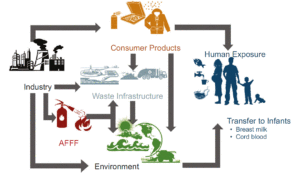Yes, forever chemicals are fueling a public health crisis
Per- and polyfluoroalkyl substances are no laughing matter
Per- and polyfluoroalkyl substances (PFAS) are ubiquitous, highly degradation-resistant contaminants. They are numerous and no one is exposed to one single PFAS molecule.

The citizen’s health must never be compromised. This is a fundamental principle that simply cannot be negotiated.
We should have known
Given the large number of substances in the PFAS family, the participants in the Zurich meeting (2017) agreed that actions needed to address groups of PFAS rather than individual chemicals and that such a grouping approach had to be scientifically sound [Ritscher et al. 2018].
Their widespread use, large numbers, and diverse chemical structures make it hard to implement any protective regulation, reduce emissions and remediate contaminated sites. Specific members of the PFAS family such as PFOS and its salts have been regulated by various authoritative bodies. Regulating only individual PFAS or a limited subset has however resulted in their replacement by other class members with less obvious hazard profiles. These alternatives may even be worse than the PFAS being replaced, thus constituting a regrettable substitution. For example, manufacturers have shifted to PFAS with six or fewer carbons, such as perfluorohexanoic acid and other short-chain substances, which are less studied but have already been documented to display multiple hazard traits [Brendel et al. 2018].
Replacing one toxic molecule by another is no solution.
Managing PFAS one by one is neither feasible nor cost-efficient
The 3M-pollution was only recently “discovered” and, in the wake of media coverage, prof Jan Tytgat of the Katholieke Universiteit Leuven stated that all Flemings have PFOS in their bodies.
Naturally, comprehensive solutions are urgently needed, since the traditional approaches have failed to control widespread PFAS exposures and have resulted in inadequate public health protection [Kwiatkowski et al. 2020]. For Europe alone, the annual health costs linked to the exposure to just a few PFAS are estimated at 52 − 84 billion Euros, and environmental remediation costs are estimated at roughly 17 billion Euros [Goldenman et al. 2019].
Kwiatkowski et al. [2020] conclude: The more we study PFAS, the more we learn about the harm they can do to our health and the environment. However, it is not possible to thoroughly assess every individual PFAS, or combination of PFAS, for their full range of effects in a reasonable time frame. Without effective risk management action around the entire class of PFAS, these chemicals will continue to accumulate and cause harm to human health and ecosystems for generations to come. The colleague who responded to my post has co-authored this Kwiatkowski-paper.
PFAS accumulating in human tissues have been shown to be toxic
Research in this field is expanding fast. We are now aware that PFAS absorbed by the intestine or inhaled may exert their toxicity acting as endocrine disruptors (EDs) affecting the reproductive system, the function of the thyroid gland, bone metabolism and leading to a number of deleterious health consequences on the immune, the nervous and, possibly, the cardiovascular system [Lindstrom et al. 2011; Kahn et al. 2020].
Tackling endocrine disruption is a major challenge for the 21st century. To be effective, the approach must be based on the evaluation of contaminant mixtures. This was suggested a long time ago, but the idea received little support by public authorities and far too few measures were taken. As long as 12 years ago, Kortenkamp wrote: I argue that the accumulated evidence seriously undermines continuation with the customary chemical-by-chemical approach to risk assessment for EDs. Instead, we should seriously consider group-wise regulation of classes of EDs.
Kortenkamp [2009] was right!
Guaranteeing public health is not possible in a polluted environment
We face a planetary chemical pollution problem − over 9000 PFAS and millions of other chemical substances are scattered around the planet Earth − and burying our heads in the sand will not make these pollutants go away. Wang et al. [2021] advocate the rapid establishment of an overarching international body to facilitate and foster efficient bi-directional science-policy interactions on chemicals and (chemical) waste: a great initiative that deserves our full attention.
Regarding PFAS, governments are recommended to apply a class-based clean-up approach by prioritising research and development funding for treatment, disposal and destruction methods that are effective for the entire class of PFAS [Kwiatkowski et al. 2020]. Treatment and disposal strategies should remove all PFAS from both impacted environmental media (e.g., water, air and soil) as well as treatment residuals (e.g., spent activated carbon and reverse osmosis concentrate).
Regulatory agencies should adopt class-based strategies to reduce exposure and minimise health risk. They should assess combined exposures to PFAS via drinking water, food, air, consumer products, and waste as a basis for setting up regulatory limits and treatment standards. Establishing limits to the class rather than doing so on a chemical-by-chemical basis will very likely result in lower exposure values that better protect vulnerable populations such as pregnant women, children, and workers.
Moreover, chemical manufacturers should focus on the development of safer nonfluorinated alternatives for currently used PFAS. They should collaborate with product manufacturers and businesses to replace all PFAS uses that already have acceptable alternatives from environmental and health perspectives. Moreover, chemical and product manufacturers must be transparent about the use of any PFAS chemistry in the supply chain and strictly monitor releases of all PFAS into the environment until their use can be phased out.
It is a great shame that transparency and honesty still need so much promotion. This cannot go on; change must come now. We face a scientific and moral imperative. If we do not act now, humans and most other species could end up marching toward the brink of obsolescence [Swan 2021].
References
Brendel et al. [2018]. Short-chain perfluoroalkyl acids: environmental concerns and a regulatory strategy under REACH, Environmental Sciences Europe 30, 1, 1 – 11
Goldenman et al. [2019]. The cost of inaction – A socioeconomic analysis of environmental and health impacts linked to exposure to PFAS, available on http://norden.diva-portal.org/smash/record.jsf?pid=diva2%3A1295959&dswid=-9122
Kahn et al. [2020]. Endocrine-disrupting chemicals: implications for human health, The Lancet Diabetes & Endocrinology 8, 8, 703 – 718
Kortenkamp [2009]. Ten years of mixing cocktails: a review of combination effects of endocrine-disrupting chemicals, Environmental health perspectives 115, Suppl 1, 98 – 105
Kwiatkowski et al. [2020]. Scientific basis for managing PFAS as a chemical class, Environmental Science & Technology Letters 7, 8, 532 – 543
Lindstrom et al. [2011]. Polyfluorinated Compounds: Past, Present, and Future, Environtal Science & Technology 45, 19, 7954 – 7961
Ritscher et al. [2018]. Zürich statement on future actions on per-and polyfluoroalkyl substances (PFASs), Environmental health perspectives 126, 8, 084502, pp. 5
Sunderland et al. [2019]. A review of the pathways of human exposure to poly-and perfluoroalkyl substances (PFASs) and present understanding of health effects, Journal of exposure science & environmental epidemiology 29, 2, 131 – 147
Swan [2020]. Count down, Scribner, pp. 292
Wang et al. [2021]. We need a global science-policy body on chemicals and waste, Science 371, 6531, 774 – 776
